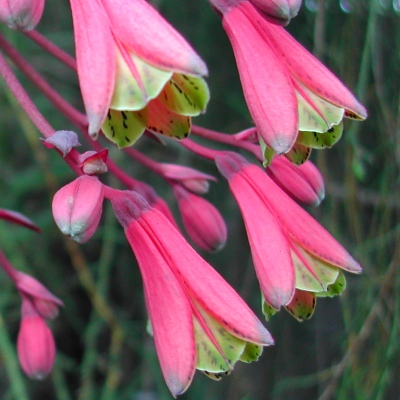Plant your seeds immediately for the best germination rate Getting started -- Before planting, soak the seeds in a cup of water for about 12 hours (not more than hours). Plant each seed in a separate pot about 2-4 inches (5-10 cm) tall, with drainage holes.
Fill them with a well draining soil mix. I use a mix of 1 part
coco fiber Place a seed on top and cover with about 1/4 inch (6 mm) of soil. Water the soil until evenly moist (but not fully saturated). Keep the pot in an area that will stay between 60-78 degrees F (15-26° C) during the day, and 55-70 F (12-21°C) at night. I have
no information about sprouting them outside this temperature range. I
recommend placing a
minimum/maximum thermometer Until the seeds sprout, keep the soil surface from drying out. If you enclose the pots in a plastic container to maintain moisture, leave it open slightly to allow some fresh air in. The seeds usually start sprouting after 5 to 7 weeks, and continue for a month. Most of the seeds should sprout by week 12, but if any do not, move the pots into the refrigerator for 6 weeks (put them in a sealed bag first). Check on them after a week, to see if any have sprouted. They should sprout within 6 weeks after removing them from the refrigerator. Light -- Bomarea comes from the forests, where it gets tree-filtered sun most of the time. It should be protected from strong sun exposure. Filtered sun is best. It does not need a lot of sun to be happy, just bright light. Transplanting -- Once the 2nd or 3rd shoot appears, you may gently transplant it to a larger container - approximately 2 quarts to 1 gallon (2 to 4 liters). Water the soil before repotting, to keep the soil ball from breaking apart, which can disturb the roots. Work your way up to a larger pot as it grows, eventually to a 5-8 gallon (20-30 liter) pot. Soil -- Bomarea likes fertile, well-draining soil. Most high-quality potting soils should work, with 1 part perlite (or pumice) added for every 2 parts soil. Avoid adding lime, since Bomareas like slightly acid soil. Watering -- Aim to keep the soil evenly moist most of the time (but not constantly soggy). Don't let it dry out. Fertilizing -- The first 2 months, feed
weekly with a small amount of dilute (1/8 strength) liquid fertilizer.
Hydroponic fertilizer
is ideal for small seedlings, because it is easily absorbed and contains all essential
nutrients. After 2 months, you may switch to a granular fertilizer Climate -- This species seems to be happiest in temperatures between 45 and 85 degrees F (7-29°C), and cool nights (below 66°F/19°C). It warmer climates, shade the pot to keep it cool, perhaps by placing the pot inside a larger, clay pot. The roots can probably handle temps in the low 20s (-6°C), but the leaves will perish. I recommend protecting the plant from all frost the first winter so it can become established. Up and away -- Bomarea likes to climb, so give it something to play on, like a trellis, fence, or another plant. Under 1/2 inch (1.5 cm) is the preferred thickness, so it can twine itself around easier. The flowers appear from the growing tips, so do not trim any shoots. If the shoots grow too long, you may wrap them down and around the trellis. Dormancy -- This Bomarea tends to die back at least partially in the winter if temperatures are cool enough. You may snip off any dead shoots, however don't dig up the tubers, as this may stress the plant. Pests to watch for -- Snails and slugs can be a problem in prone areas. Watch for other pests that are common in your area. Feel free to email me if you have questions. Happy growing! - Jeff Strange Wonderful Things
|
|||||||||


